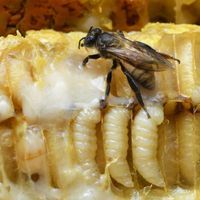ABOVE: © ISTOCK, APISITWILIAJIT
The bee genome has a superpower. Not only can the exact same DNA sequence yield three types of insect—worker, drone, and queen—that look and behave very differently, but, in the case of workers, it dictates different sets of behaviors.
A key to the genome’s versatility seems to be epigenetic changes—chemical tags that, when added or removed from DNA, change the activity of a gene. Previous studies had shown distinct patterns of tags known as methyl groups on the genomes of bees performing different roles within their hives.
See “Controlling Bee Fate”
In a study published in Genome Research last month, Paul Hurd, an epigenetics researcher at Queen Mary University of London, and colleagues looked at a different type of epigenetic change: histone modifications. DNA wraps around histones, and chemical modifications to these proteins are thought to affect how available genes are to...
In their new study, the researchers report that queen and worker bees each have characteristic patterns of histone modifications on their genomes, and that these differences emerge very early in development, suggesting they may be key to determining the insects’ fates.
The very different individuals that arise from hive members’ identical genomes have made the honeybee “one of the most well-known and striking examples of phenotypic plasticity,” says Gene Robinson, a genomicist at the University of Illinois who was not involved in the study. Bees are a model, he says, for “understanding how environmental signals are transduced and then trigger these alternate developmental pathways.”
Larvae are sent down different developmental pathways from the time of hatching by nurse bees (a type of worker), which tailor the insects’ diets according to their future castes. Worker bees that tend to queen larvae and mature queens make their special food, so-called royal jelly, themselves, and it contains a compound known to directly influence histone modifications, the authors note in their paper.
The authors suggest that the histone modifications drive differences in gene transcription among bees of different castes, which in turn guide them down different developmental paths.
No previous studies had examined whether histone modifications might help steer development in bees, even though, Hurd notes, unlike methyl tags, which are restricted to certain stretches of DNA in honeybees, “the histones are all over the genome.” To investigate their role, the research team collected worker and queen bee eggs and larvae from Apis mellifera hives and sampled the larvae 96 hours after they hatched. The team then analyzed the bee genomes for the positions of three different types of histone modifications.
At 96 hours, the researchers found, the genomes of future workers and queens already had “striking differences” in their patterns of histone modifications, says Robert Lowe, a computational biologist at Queen Mary University of London and one of the paper’s authors. And the locations of the histones that were modified differently in workers and queens corresponded with the sites of genes that have different expression levels between the two populations.
The authors suggest that the histone modifications drive differences in gene transcription among bees of different castes, which in turn guide them down different developmental paths.
Elena Torlai Triglia, who studies chromatin modification and transcriptional regulation at the Broad Institute in Massachusetts and was not involved in the study, says the relationship between histone modification and gene transcription in honeybees is “still a bit of a mystery.” To nail down cause and effect, she suggests, a study would need to alter the histone marks and see whether changes in gene transcription and phenotype occurred as a result—a step the authors didn’t take, but plan to in future experiments, Hurd says.
Lowe notes that unlike the popular lab insect Drosophila, bees have all the same types of epigenetic marks humans do, making them useful subjects for understanding those modifications. One question they’d like to look into, Hurd says, is whether pesticides affect bees’ epigenetic marks.
Interested in reading more?







